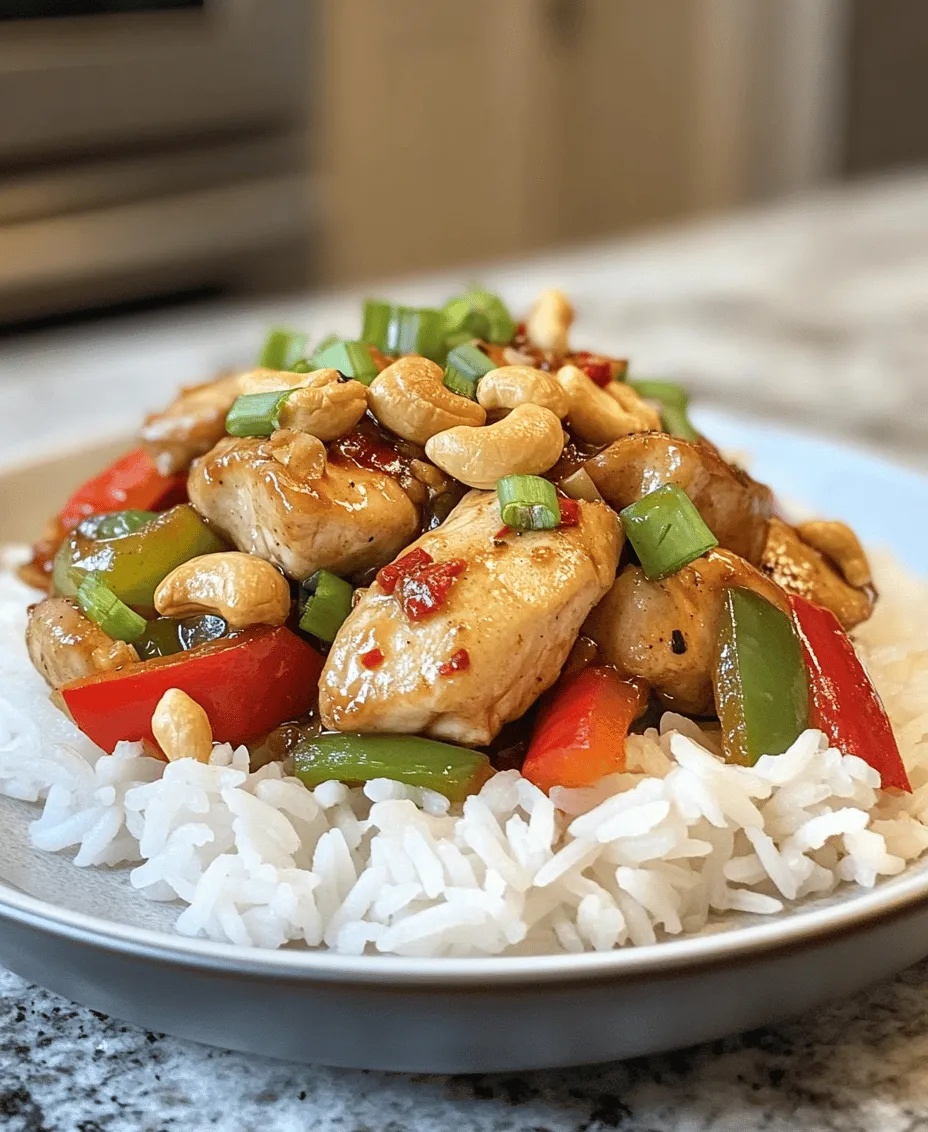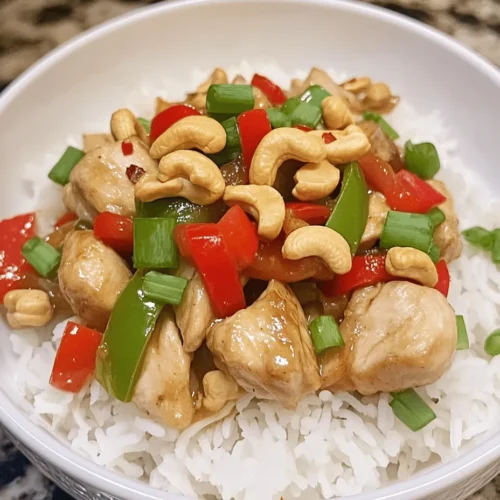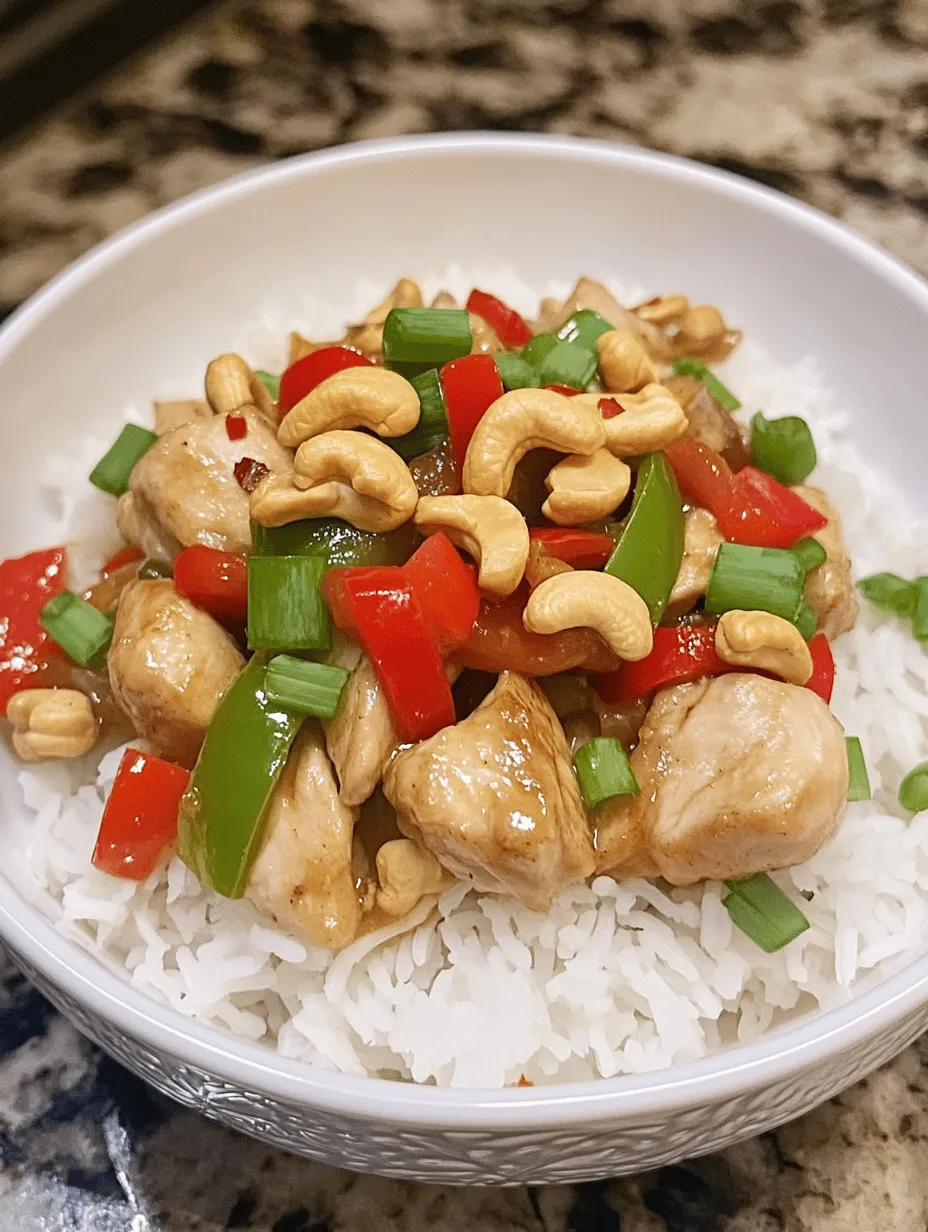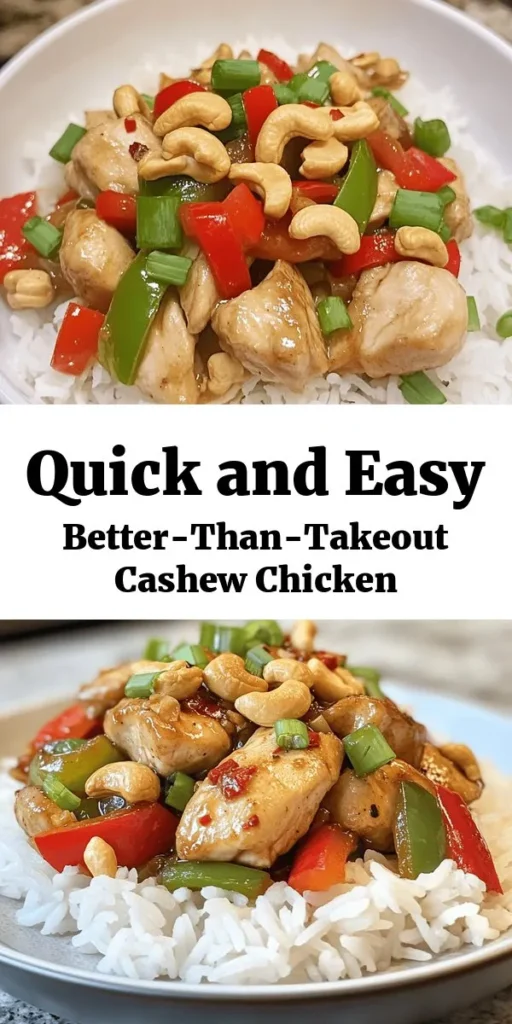Introduction
In recent years, the convenience of takeout has made it a staple for many households, promising quick and delicious meals without any mess in the kitchen. However, as the trend towards healthier eating continues to rise, many home cooks are seeking homemade alternatives that not only satisfy their cravings but also align with their health goals. Among the myriad of options available, Cashew Chicken stands out as a particularly appealing choice.
This beloved dish in Chinese cuisine has captured the hearts (and taste buds) of many with its delightful combination of tender chicken, crunchy cashews, and vibrant vegetables, all enveloped in a savory sauce. The flavor profile is nothing short of irresistible, showcasing a balance of sweetness and umami that is both comforting and satisfying.
What truly sets this Better-Than-Takeout Cashew Chicken apart from its restaurant counterpart is the ability to control ingredients, portion sizes, and most importantly, the freshness of the components. By opting for a homemade version, you’re not just ensuring a meal that’s tailored to your taste preferences but also one that comes with numerous health benefits. The freshness of the ingredients means you’re avoiding the preservatives and excess sodium often found in takeout versions, making this dish a far superior choice for health-conscious eaters.
Understanding Cashew Chicken
To appreciate the Better-Than-Takeout Cashew Chicken fully, it’s essential to delve into the dish’s rich history and its evolution in Chinese-American cuisine. Originating in the United States, Cashew Chicken was popularized in the 1960s, particularly in cities with a significant Chinese immigrant population. The dish is believed to have been inspired by traditional Chinese cooking methods, marrying them with American tastes and ingredients.
While the core components—chicken and cashews—remain consistent, variations of Cashew Chicken abound. Different regions have put their spin on the dish, leading to an array of interpretations. For example, in some places, you might find it served with a heavier sauce or accompanied by steamed rice, while others might present it as a stir-fry with an emphasis on colorful vegetables. This adaptability is part of what makes Cashew Chicken a beloved dish across various cultures.
From a nutritional standpoint, Cashew Chicken offers a wealth of benefits. The primary ingredient, chicken, serves as an excellent source of lean protein, essential for maintaining muscle mass and aiding in recovery. Cashews, on the other hand, bring a crunch that complements the dish’s texture and are packed with heart-healthy fats, vitamins, and minerals. They are a good source of magnesium, which plays a crucial role in muscle and nerve function, as well as energy production. Coupled with colorful vegetables like bell peppers and broccoli, you’re not just indulging in a flavorful meal; you’re also nourishing your body with essential nutrients.
Ingredient Breakdown
Let’s dive deeper into the ingredients that make this dish both delicious and nutritious. Understanding the purpose of each component not only enhances your cooking skills but also allows you to appreciate the complexity of the flavors involved.
Chicken
The backbone of our Cashew Chicken recipe is, of course, the chicken itself. Using boneless, skinless chicken breasts is crucial for achieving a lean protein source that cooks quickly and absorbs the flavors of the other ingredients beautifully. Chicken breasts are low in fat and high in protein, making them an ideal choice for those looking to maintain a healthy diet. Cutting the chicken into bite-sized pieces ensures even cooking and allows for better incorporation with the vegetables and sauce.
Cashews
Next up is the star ingredient—cashews. These creamy, slightly sweet nuts add a unique texture and flavor to the dish. Nutritionally, cashews are a powerhouse, providing healthy monounsaturated fats, protein, and essential minerals like copper and manganese. They also contain antioxidants that can help reduce inflammation in the body. When roasted, cashews develop a deeper flavor, which enhances the overall taste of the dish. Toasting them lightly before adding them to the stir-fry can elevate the dish further by intensifying their nutty profile.
Vegetables
In addition to chicken and cashews, a variety of vegetables contribute to the dish’s flavor and nutritional content. Bell peppers, onions, garlic, and ginger are common choices that not only add color but also pack a punch of flavor.
– Bell Peppers: These vibrant vegetables are rich in vitamins A and C, providing a sweet crunch that contrasts beautifully with the savory elements of the dish. They also add a pop of color, making the meal visually appealing.
– Onions: Essential for building flavor, onions add sweetness and depth to the dish. They caramelize beautifully when cooked, enhancing the overall taste profile.
– Garlic and Ginger: These two aromatics are integral to many Asian dishes. Garlic offers a pungent, robust flavor, while ginger adds warmth and spice, creating a harmonious balance in the dish.
Incorporating a mix of these vegetables not only boosts the nutritional value but also creates a well-rounded meal that is both satisfying and healthy.
Sauces
The sauces used in Cashew Chicken are fundamental to achieving the dish’s signature flavor. A blend of soy sauce, hoisin sauce, and rice vinegar creates a perfect harmony of savory, sweet, and tangy notes.
– Soy Sauce: This staple in Asian cooking provides umami and saltiness, essential for flavoring the dish. Opt for low-sodium soy sauce if you are watching your salt intake.
– Hoisin Sauce: Known for its sweet and tangy profile, hoisin sauce adds richness and complexity to the dish. It’s a key ingredient that differentiates Cashew Chicken from other stir-fries.
– Rice Vinegar: This milder vinegar helps to balance the flavors and adds a subtle acidity that enhances the overall dish. It complements the sweetness of the hoisin and the saltiness of the soy sauce.
By using these sauces in moderation, you can control the flavor intensity while keeping the dish on the healthier side.
Suggestions for Ingredient Substitutions
One of the beauties of cooking at home is the ability to customize recipes according to dietary preferences and restrictions. If you’re looking for a vegetarian or vegan version of Cashew Chicken, consider swapping out the chicken for tofu. Tofu is an excellent source of plant-based protein and absorbs flavors beautifully, making it a versatile alternative.
For those with nut allergies, you can replace cashews with sunflower seeds or pumpkin seeds, which will still provide a satisfying crunch without the risk of an allergic reaction. Alternatively, you can simply omit the nuts altogether and focus on the vibrant vegetables and protein source.
By understanding the purpose and nutritional benefits of each ingredient, you’ll be well-equipped to make your own Better-Than-Takeout Cashew Chicken, ensuring it’s not just delicious but also tailored to your taste and health needs. Now, let’s move on to the next steps involved in creating this delightful dish from scratch.

Preparation Steps
To achieve the best flavor and texture in your Better-Than-Takeout Cashew Chicken, follow these meticulous preparation steps that enhance the dish’s overall quality.
Toasting Cashews for Maximum Flavor
Begin by toasting your cashews. This step is crucial as it brings out the nutty flavor and adds a delightful crunch. Here’s how to do it:
1. Choose the Right Pan: Use a dry skillet or frying pan, preferably non-stick, to avoid sticking.
2. Heat the Pan: Place the skillet over medium heat and allow it to warm up for about 2 minutes.
3. Add Cashews: Once the pan is hot, add the raw cashews.
4. Toast: Stir the nuts frequently to ensure they toast evenly, which typically takes about 5-7 minutes. You want them to turn golden brown and emit a nutty aroma.
5. Cool: Once toasted, transfer the cashews to a plate to cool. This prevents them from continuing to cook and becoming too dark.
Toasting cashews not only enhances their flavor but also adds a pleasant texture to your dish.
Marinating Chicken for Enhanced Flavor
Marinating chicken is a fundamental step that enhances the flavor profile of your cashew chicken. Here’s how to properly marinate:
1. Prepare the Marinade: In a bowl, mix together 1 tablespoon of soy sauce, 1 tablespoon of cornstarch, and a dash of sesame oil. You can also add minced garlic or ginger for extra flavor.
2. Cut the Chicken: Use boneless, skinless chicken breast or thighs. Cut into bite-sized pieces to ensure even cooking.
3. Combine: Add the chicken pieces to the marinade, ensuring they are well-coated. Allow the chicken to marinate for at least 30 minutes. For best results, marinate for 2 hours in the refrigerator. This allows the flavors to penetrate the chicken, making it tender and flavorful.
Marinating not only infuses the chicken with flavor but also helps to keep it moist during cooking.
Cooking Chicken and Vegetables
Cooking your chicken and vegetables properly is key to achieving the perfect texture and taste. Follow these steps:
1. Preheat Your Wok or Skillet: Heat a tablespoon of oil (vegetable or peanut oil works well) in a large wok or skillet over medium-high heat.
2. Cook the Chicken: Add the marinated chicken to the pan in a single layer. Let it sear without moving it for about 2-3 minutes until it gets a nice golden color. Then stir-fry for another 2-3 minutes until cooked through. Remove the chicken from the pan and set aside.
3. Cook the Vegetables: In the same pan, add a splash more oil if necessary. Add your chopped vegetables, such as bell peppers, broccoli, and snap peas. Stir-fry for 3-4 minutes until they are vibrant and slightly tender but still crisp.
4. Combine Chicken and Veggies: Return the cooked chicken to the pan, mixing it with the vegetables.
5. Add the Sauce: Pour in your prepared sauce (which we will discuss shortly) and let it simmer for a minute until it thickens slightly, coating the chicken and vegetables.
Proper cooking techniques, such as searing and stir-frying, preserve the natural textures of the chicken and vegetables while enhancing their flavors.
Understanding the Cornstarch Slurry
The cornstarch slurry is a vital component that helps achieve the desired consistency of your sauce. To create a cornstarch slurry:
1. Mix Cornstarch and Water: In a small bowl, combine 1 tablespoon of cornstarch with 2 tablespoons of cold water. Stir until smooth.
2. Incorporate into Sauce: Add the slurry to your stir-fry towards the end of cooking. This will thicken the sauce, giving it a more luxurious and clingy texture that coats the chicken and vegetables beautifully.
Using a cornstarch slurry not only thickens the sauce but also gives it a glossy finish that is visually appealing.
Serving Suggestions
Now that your Better-Than-Takeout Cashew Chicken is ready, it’s time to think about serving it in an appealing way.
Pairing with Rice or Noodles
Cashew chicken pairs excellently with both rice and noodles. Here are a few ideas:
– Rice: Serve over fluffy white rice, brown rice, or even cauliflower rice for a low-carb option. The rice absorbs the delicious sauce, making each bite flavorful.
– Noodles: For a more substantial meal, serve the cashew chicken over cooked lo mein or rice noodles. Toss the noodles in the sauce for an integrated taste.
Portion Sizes and Serving for Gatherings
When serving Cashew Chicken for family meals or gatherings, consider these portion suggestions:
– Individual Servings: A typical serving size is about one cup of cashew chicken with half a cup of rice or noodles. This balance ensures everyone enjoys a satisfying meal without feeling overly stuffed.
– Family Style: For larger gatherings, serve in a large bowl with a ladle, allowing guests to help themselves. This approach fosters a communal dining experience.
Garnishing and Presentation
Make your dish visually appealing with simple garnishes:
– Green Onions: Chop fresh green onions and sprinkle them over the top before serving for a pop of color and freshness.
– Optional Spice: If your guests enjoy a bit of heat, consider adding a sprinkle of red pepper flakes or a drizzle of sriracha on the side.
A well-presented dish enhances the dining experience, making your homemade Cashew Chicken even more inviting.
Health Benefits of Homemade Cashew Chicken
One of the best aspects of preparing Better-Than-Takeout Cashew Chicken at home is the control you have over the ingredients, leading to a healthier meal option.
Homemade vs. Takeout
When comparing homemade Cashew Chicken to takeout options:
– Calorie Count: Homemade versions can be lower in calories, especially when using lean cuts of chicken and minimizing oil.
– Sodium Levels: Takeout often contains high sodium levels due to sauces and preservatives. By making it at home, you can significantly reduce sodium levels by controlling the amount of soy sauce and using low-sodium alternatives.
– Preservatives: Homemade meals are free from artificial preservatives and additives, making them a healthier choice.
Health Benefits of Fresh Ingredients
Using fresh ingredients in your Cashew Chicken not only enhances flavor but also boosts nutritional value:
– Nutrient Density: Fresh vegetables add vitamins, minerals, and fiber, making the dish more nourishing.
– Protein Power: Chicken is a high-quality protein source, essential for muscle repair and overall health.
– Healthy Fats: Cashews provide healthy fats, which are beneficial for heart health when consumed in moderation.
Dietary Compatibility
This dish can also fit into various dietary preferences:
– Low-Carb: Serve it over cauliflower rice or omit the rice altogether to keep carbohydrate intake low.
– High-Protein: With lean chicken and nuts, this recipe is naturally high in protein, making it suitable for those looking to increase their protein intake.
– Balanced Meal: By incorporating a variety of vegetables, you ensure a balanced meal that is both satisfying and nutritious.
Conclusion
Preparing Better-Than-Takeout Cashew Chicken at home offers numerous benefits that go beyond taste. Not only do you have control over the ingredients, but you also get to customize the flavors to suit your preferences, making this dish uniquely yours.
Experimenting with different vegetables, sauces, and spices can lead to exciting variations that keep your meals fresh and enjoyable. Moreover, the satisfaction of cooking a beloved dish that you can enjoy guilt-free is unmatched.
So why not roll up your sleeves and give this recipe a try? You’ll find that making your own Cashew Chicken is not only rewarding but also a deliciously healthy alternative to takeout. Enjoy the process and relish the flavors of your homemade creation.



